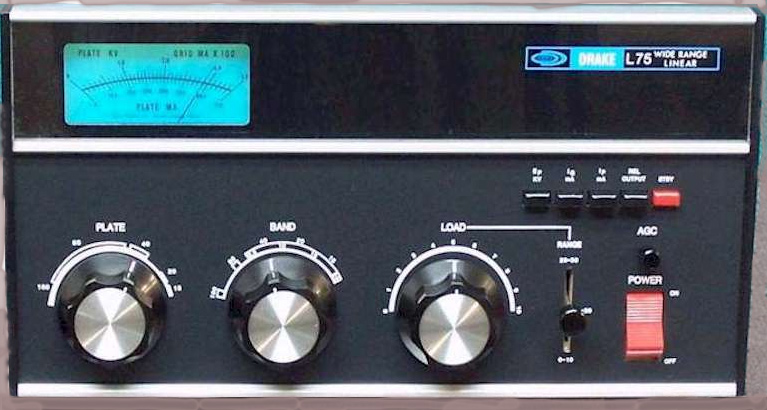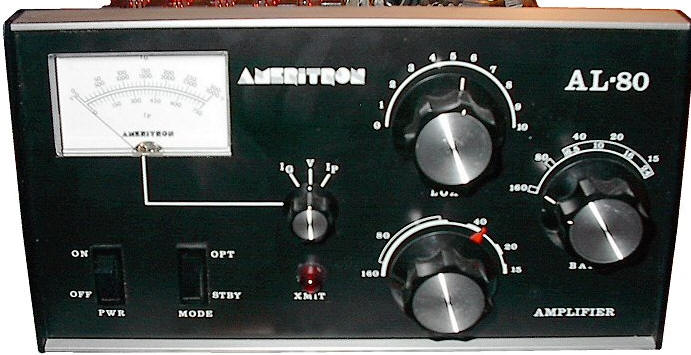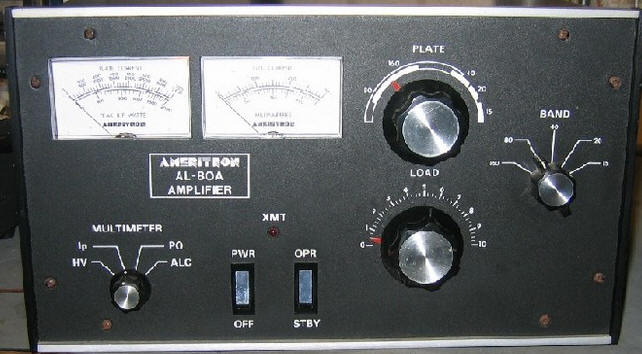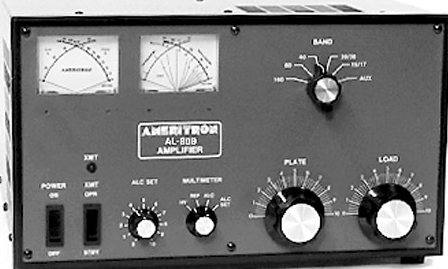Ameritron initially started in Twinsburg, Ohio around 1980. The staff included former Dentron employees. Ameritron was formed through a working relationship between John Moran (sk W8IOB) and Denny Had (ex-K8KXK).
John Moran, W8IOB, was formerly at the famous Bud Radio (during and after WWII era). John owned Prime Instruments, he started Actron. Prime and Actron designed and manufactured meters, gauges, timing lights, and other aftermarket automotive electronics and test equipment. John Moran was one of the most straight forward and honest businessmen I ever met in my life. His word was as good as gold, and he never believed in misleading people. John never deviated from complete honesty and integrity. John enjoyed Ameritron as a hobby, and enjoyed doing drawings.
Ameritron was initially formed by some former Dentron staff, a while after Dentron went belly-up. Ameritron was not Dentron, but had some of the same staff. Prime, owned by John Moran, purchased parts, tooling, and other things necessary to help start Ameritron. Prime built the initial amplifiers and sent them to Twinsburg for final testing and approval, and shipping.
I came into the picture as a consultant at Twinsburg. Denny was a great guy and we got along well, you couldn't ask for a nicer person. We did disagree on engineering focus (I thought it was an almost complete lack of engineering), and would pick at each other. In my opinion Denny had a heart of gold, had great love for being in the business, but unfortunately got started with a pretty poor designer helping him. Denny was a wonderful marketing person, and one of the most enthusiastic and kind-hearted people I ever met. Unfortunately, Denny was surrounded by people who had no idea how to build anything.
The Ameritron AL-80 started as a copy or knock-off of the Drake L-5. The early AL80 used a blue-tint meter bezel on a two-scale panel meter, the same basic knob labels and knobs, similar front trim, and similar overall layout.

Above is drake L75

The above is a Prime Instruments reworked AL80. It has a clear face three scale meter, along with many other changes.
People incorrectly set the value of the AL80 similar to the AL80A. There is no way the AL80 should ever be compared to the AL80A, and the AL80A be compared to the AL80B. They are all completely different, except for using the same tube types! If you hear people describing the AL80 value or design as being similar or comparable to the AL80A value, they don't know what they are talking about. The same is true for the AL80A / SB1000 compared to the AL80B.
The AL80, AL80A, and AL80B are all entirely different designs, other than sharing the same tube.
Original AL80
The original AL80 with serial numbers below S/N 200 was actually not fit for marketing. Like other early Twinsburg equipment, it used components and wire from a surplus store in downtown Cleveland. This struck me as strange, because new parts were no more expensive than surplus parts.
The initial AL80 used what I call "rat's nest" wiring. The wiring was point-to-point using surplus Teflon wire. Rat's nest hand wiring made wiring ugly and unprofessional. The amplifier used the wrong hardware, wrong types or values of components, and the cabinet was too small. The 3-500Z tube, even without drive power, ran above Eimac seal temperature ratings. Input circuit and tank values were incorrect.
John was initially unaware of the poor design quality. When John assumed full control of Ameritron, John agreed to immediately correct AL-80 design flaws at his own expense. The initial AL-80 units had the following problems:
1.) 100K 2-watt carbon bleeder resistors that would go down in value, crack, and eventually open. This would cause premature electrolytic failures. Carbon resistors should never be used in HV bleeder/equalizer applications, because they age down in value with long term heating. I replaced the carbons with 100k 2-watt metal oxide resistors
2.) 1/8th watt resistors across the diodes. These small resistors had a voltage rating of 300 volts, but were across 1000 volt rated diodes. They were removed.
3.) Excessive filament voltage. We re-specified the transformer.
4.) A wrong tank switch design. The original AL80 amplifier used a make-before-break (or standard CRL shorting wafer). This decreased contact spacing, greatly reducing bandswitch voltage breakdown. The switch also had unnecessary sections and unnecessary contacts, driving the switch cost up while compromising reliability. It also had poor switch contact layout, placing high voltage terminals near grounded or lower voltage switch areas. This was incredibly poor switch planning, some of the worse I ever saw. A redesigned switch was much more reliable and easier to wire, while also reducing cost and assembly time.
5.) Too little cabinet height, forcing the 3-500Z cap near the cabinet cover. The tube anode would actually arc to the cabinet top. I reduced socket height and clearance the filament pins with clearance holes.
6.) Odd custom meter shunt resistor values (0.234 ohm) from poor meter circuit planning. The original meter read plate current and grid current on the same 750 mA current scale. I changed shunts to standard resistor values of 1.5 and 0.6 ohms, and replaced the meter with a 450-ohm 1 mA tri-scale meter. This gave scales of 0-300 mA grid current and 0-750 mA plate current, placing the plate and grid current running values near mid-scale.
7.) Wrong tuned input values. The tuned input did not act like a pi-network. I corrected the values.
8.) Plate choke resonances inside Ham bands. I corrected the choke design.
9.) Wrong tank components, including inductances, causing grossly wrong tank Q's. I corrected tank components.
10.) Point-to-point wiring was replaced with harnesses using irradiated PVC wires, with standard color coding for wiring.
11.) Inadequate cooling. Many chassis ventilation holes were relocated, new holes added, and the fan changed to a proper speed fan.
12.) Weak chassis. It had an aluminum chassis, and had to be shipped with a wooden board for support.
The original early AL-80 had many design and parts selection flaws, and was almost non-producible from a production standpoint. All field units, because of grossly inadequate design and components, were rebuilt at Prime's expense. Rebuilt units were given new serial numbers.
Serial Number History Ameritron AL80 (NOT dual meter A models)
| S/N | Date | Status |
| less than 200 | late 1980 - 1983 | about 100 units sold, all defective designs. These units have no value unless repaired |
| 300-499 | 1983 - 1984 | original units fully rebuilt at Prime's expense. Rebuild cost about $300-400 each |
| 500 until end | 1983 until start of AL80A in 1984-1/2 | new production units, with all early design errors corrected. These numbers overlapped the rebuilds. |
The AL-80A (1984-1/2 on)

The AL80A was NOT the same as the AL80 above. The AL80A was a fully-new design. The AL80A, because of improved quality, drove Ameritron sales upwards from around 5-10 units monthly up to about 50 units a month. The original AL80 was built with a focus on size. The AL80A was built with a focus on performance and value, with no regard to size. The size had to be what it had to be in order to work optimally.
The AL80A had the following production modifications or revisions:
1.) The ATI-6 tuned input board disappeared. A new slug-tuned coil system, housed in a metal chassis, was used. This system was directly switched, eliminating relays.
2.) The power transformer was up-sized.
3.) Airflow was changed by moving the fan to the center panel. This kept heat off the fan, and allowed the fan to blow cool air directly across the tube.
4.) The AL-80A used two panel meters, the right meter was exclusively dedicated to grid current (AL80 had one panel meter). The left meter was a multimeter.
5.) The AL80A used standard computer-grade capacitors
6.) Cabinet and chassis was larger, and steel
7.) Tank was redesigned with new components, including higher Q air-dux coils
8.) HV was increased
9.) Zener bias was added
10.) Fusing was improved
Very little was common between the AL80 and the AL80A. The AL80 and AL80A are, even though each use a single 3-500Z, entirely different amplifiers. The AL80A boot-strapped the early AL80 reputation up, and caused a used price increase in the AL80 (that never should have happened).
I left Ameritron to work for Heathkit sometime after the AL80A was up and running. I brokered a deal where Heath sold the AL80A as an SB1000.
AL80B

The AL80B superseded the AL80A. The AL80B was my update of the earlier Ameritron design. This revision occurred after MFJ purchased Ameritron. The AL80B has very little common with the AL80A. The AL80B started around 1990 or so. The AL80B received the following upgrades:
1.) A larger transformer with more voltage flexibility
2.) Accurate peak reading directional coupler power meter
3.) Dynamic bias
4.) More use of printed circuit boards
5.) Two cross-needle panel meters reading a total of eight different parameters.